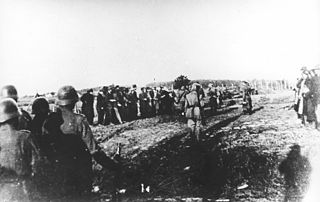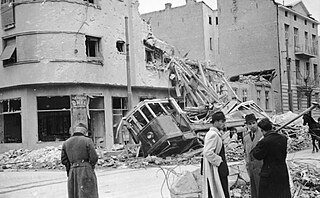 W
WThe 342nd Infantry Division was a formation of the German Wehrmacht during World War II. Established on 19 November 1940, it was formed from elements of two existing divisions. It first served as part of the occupation forces in France between June and September 1941 and was then largely responsible for the brutal repression of resistance in eastern parts of Axis-occupied Yugoslavia between September 1941 and February 1942.
 W
WThe Occupation of Vojvodina from 1941 to 1944 was carried out by Nazi Germany and its client states / puppet regimes: Horthy's Hungary and Independent State of Croatia.
 W
WThe Banjica concentration camp was a Nazi German concentration camp in the Territory of the Military Commander in Serbia, the military administration of the Third Reich established after the Invasion and occupation of Yugoslavia during World War II. In response to escalating resistance, the German army instituted severe repressive measures – mass executions of civilian hostages and the establishment of concentration camps. Located in the Banjica neighborhood of Dedinje—a suburb of Belgrade—it was originally used by the Germans as a center for holding hostages. The camp was later used to hold anti-fascist Serbs, Jews, Roma, captured Partisans, Chetniks and other opponents of Nazi Germany. By 1942, most executions occurred at the firing ranges at Jajinci, Marinkova Bara and the Jewish cemetery.
 W
WThe Crveni Krst concentration camp, also known as the Niš concentration camp, located in Crveni Krst, Niš, was operated by the German Gestapo and used to hold captured Serbs, Jews and Romanis during the Second World War. Established in mid-1941, it was used to detain as many as 35,000 people during the war and was liberated by the Yugoslav Partisans in 1944. More than 10,000 people are thought to have been killed at the camp. After the war, a memorial to the victims of the camp was erected on Mount Bubanj, where many inmates were shot. A memorial museum was opened on the former campgrounds in 1967 and in 1979 the campgrounds were declared a Cultural Monument of Exceptional Importance and came under the protection of the Socialist Republic of Serbia.
 W
WThe Kragujevac massacre was the mass murder of between 2,778 and 2,794 mostly Serb men and boys in Kragujevac by German soldiers on 21 October 1941. It occurred in the German-occupied territory of Serbia during World War II, and came as a reprisal for insurgent attacks in the Gornji Milanovac district that resulted in the deaths of 10 German soldiers and the wounding of 26 others. The number of hostages to be shot was calculated as a ratio of 100 hostages executed for every German soldier killed and 50 hostages executed for every German soldier wounded, a formula devised by Adolf Hitler with the intent of suppressing anti-Nazi resistance in Eastern Europe.
 W
WThe Kraljevo massacre was the mass murder of approximately 2,000 residents of the central Serbian city of Kraljevo by the Wehrmacht between 15 and 20 October 1941, during World War II. The massacre came in reprisal for a joint Partisan–Chetnik attack on a German garrison during the Siege of Kraljevo in which 10 German soldiers were killed and 14 wounded. The number of hostages to be shot was calculated based on a ratio of 100 hostages executed for every German soldier killed and 50 hostages executed for every German soldier wounded, a formula devised by Adolf Hitler with the intent of suppressing anti-Nazi resistance in Eastern Europe.
 W
WOperation Retribution, also known as Operation Punishment, was the April 1941 German bombing of Belgrade, the capital of Yugoslavia, in retaliation for the coup d'état that overthrew the government that had signed the Tripartite Pact. The bombing occurred in the first days of the German-led Axis invasion of Yugoslavia during World War II. The Royal Yugoslav Army Air Force (VVKJ) had only 77 modern fighter aircraft available to defend Belgrade against the hundreds of German fighters and bombers that struck in the first wave early on 6 April. Three days prior, VVKJ Major Vladimir Kren had defected to the Germans, disclosing the locations of multiple military assets and divulging the VVKJ's codes.
 W
WThe Sajmište concentration camp was a Nazi concentration and extermination camp during World War II. It was located at the former Belgrade fairground site near the town of Zemun, in the Independent State of Croatia (NDH). The camp was organized and operated by SS Einsatzgruppen units stationed in occupied Serbia. It became operational in September 1941 and was officially opened on 28 October of that year. The Germans dubbed it the Jewish camp in Zemun. At the end of 1941 and the beginning of 1942, thousands of Jewish women, children and old men were brought to the camp, along with 500 Jewish men and 292 Romani women and children, most of whom were from Niš, Smederevo and Šabac. Women and children were placed in makeshift barracks and suffered during numerous influenza epidemics. Kept in squalid conditions, they were provided with inadequate amounts of food and many froze to death during the winter of 1941–42. Between March and May 1942, the Germans used a gas van sent from Berlin to kill thousands of Jewish inmates.
 W
WThe Topovske Šupe concentration camp was a concentration camp located on the outskirts of Belgrade which was operated by Nazi Germany with the help of Milan Nedić's quisling government during World War II. Located in the neighborhood of Autokomanda, on the site of an old military base, the camp held between 5,000 and 6,500 inmates from its establishment in August 1941 until its closure that December. About 4,300 inmates were killed during its operation, of whom 3,000 were killed as hostages and 1,300 as suspected anti-fascists.